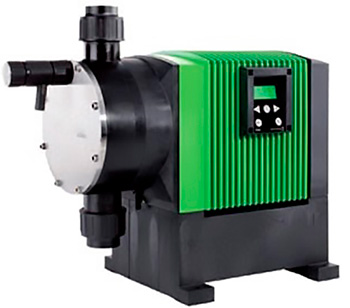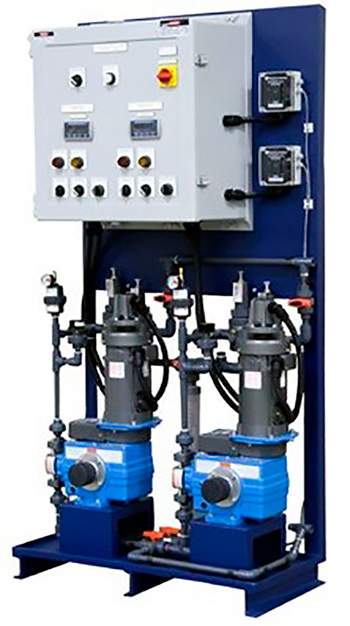Q. What types of pumps are used to disinfect or treat water?
A. About two thirds of the earth’s surface is covered by water, but most of it is not potable. The purpose of a water treatment system is to provide quality water for safe consumption (potable) or for safe release to the environment (effluent).
Water treatment to produce potable water from surface water typically consists of physical and chemical separation processes to remove constituents from the water, and to kill or inactivate disease-causing microorganisms and viruses.
Physical removal can be accomplished with use of flash mixing, flocculation, sedimentation basins, sand filters or membranes.
In both water and wastewater treatment plants, metering pumps are recommended for the disinfection process.
Disinfection is normally one of the final processes before discharge to the distribution system or release of the effluent. This final step ensures that any disease causing or pathogenic microorganisms are substantially reduced and that the water is safe to consume or release to the environment.
 Image 1. Chemical feed pump (Images courtesy of Hydraulic Institute)
Image 1. Chemical feed pump (Images courtesy of Hydraulic Institute)The effectiveness of disinfection depends on the state of the water or effluent being treated, the type of disinfection being used, the disinfectant dosage (concentration and time) and other environmental variables.
Common methods of disinfection include application of ozone, chlorine, ultraviolet (UV) light or sodium hypochlorite. Additionally, final processes can include reaeration and dechlorination in wastewater treatment plants.
Materials selection is made to ensure compatibility with the pumped liquid for corrosion resistance. Each chemical feed system can be different depending on the type of chemical to be pumped, its concentration and the necessary feed rate. Small feed rates will require diaphragm- or metering-type pumps (see Images 1 and 2).
 Image 2. Chemical feed pump assembly
Image 2. Chemical feed pump assemblyMetering units allow for a specific dose of the chemical to enter the receiving stream. Selecting the appropriate metering pump is based on the required chemical injection rate. Larger feed rates or large diluted feed streams can use centrifugal pumps to supply chemicals.
Q. What are the items to consider when selecting a pump for a wastewater treatment process?
A. Water or wastewater treatment plants have many systems of varying pumping requirements.
Some pumping characteristics that are important for different processes:
- ability to handle high to low and variable viscosity
- ability to pump solids
- sealless pumping
- self-priming
- flow repeatability
The process of pump selection includes reviewing the following:
- The process application
- fluid characteristics
- batch or continuous process
- The system hydraulics
- operating envelope
- system curves
- The selection of pump and appropriate controls to meet the process application and operating envelope
- The material selection to ensure reliable operation
Filter backwash is a process of the tertiary treatment, which is a final treatment stage to improve the effluent quality before it is discharged from the plant to the environment.
In this process, an effluent filter is used to remove most remaining suspended particles in the wastewater. Multimedia filters require a backwash water supply and a backwash discharge system.
A filter backwash (pump) is used to clean the filter bed of captured particles and prepare the bed for the next filter run.
Filter backwash water pumps need to operate on a cyclical basis, some by time, others by filter differential pressure. The water that will be pumped is clean or treated water, normally the filtered water from the process. This water will be free of solids and normally pH neutral.
Based on the clean water and operating conditions several types of rotodynamic pumps are suitable for this process.
These include horizontal end suction pumps, horizontal split case pumps, vertical turbine pumps and submersible pumps.
The recommended materials of construction are as follows:
- casing – ductile iron
- impeller – aluminum bronze, nickel aluminum bronze or 316 stainless steel
- shaft – stainless steel
- seal – packing or mechanical
HI’s Pump Application Guideline Wastewater Treatment Plant Pumps: Guidelines for Selection, Application, and Operation aids engineers, trainers, maintenance staff, and plant operators with the knowledge necessary to effectively specify pumps in a typical aerobic wastewater treatment plant employing conventional activated sludge processes. HI is working to publish and release a guideline for water treatment plant pumps in late 2017.


